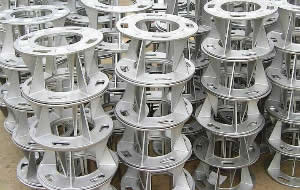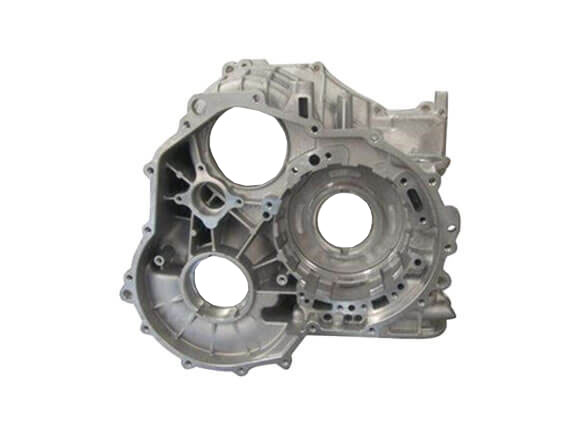Aluminum Casting Explained: Secret Truths and Insights for Market Professionals
Aluminum casting acts as an essential process in modern-day manufacturing, shaping elements across different fields. Its varied techniques, such as sand and die casting, provide to various production needs. The distinct residential or commercial properties of aluminum alloys improve their applicability, yet challenges continue to be in maintaining high quality and effectiveness. Understanding these facets is necessary for industry specialists. What are the most current innovations and finest methods that can better maximize this procedure?
Introduction of Aluminum Casting Processes

Secret aspects of aluminum casting processes include the prep work of molds, which might be made from sand, metal, or ceramic products, depending upon the planned usage. In addition, temperature level control is essential to ensure appropriate melting and solidification of aluminum.
The casting process permits detailed layouts and can attain high levels of dimensional precision. When cooled down, the spreadings might go through ending up procedures such as machining or surface area therapy to meet particular efficiency criteria. Overall, aluminum casting works as a versatile manufacturing method, efficiently meeting the diverse requirements of numerous sectors.
Kinds Of Aluminum Casting Methods
In the domain of aluminum casting, numerous approaches are used to accomplish various outcomes. Sand casting strategies provide adaptability and cost-effectiveness for complicated shapes, while die casting processes use high accuracy and effectiveness for automation. Recognizing these methods is crucial for choosing the appropriate technique based on job needs.
Sand Casting Methods
Sand casting methods represent a fundamental approach in aluminum casting, where sand is made use of as a mold and mildew product to shape molten metal. This procedure involves producing a pattern from the wanted component, which is after that positioned in a sand mixture to create a mold. The sand is compressed around the pattern, and after removal, it produces a cavity in the shape of the part. Molten aluminum is poured into this tooth cavity, enabling it to cool and solidify. One significant benefit of sand casting is its versatility; it can suit complex shapes and big components. Additionally, the materials used are relatively low-cost, making it an accessible alternative for different production applications in the aluminum market.
Die Casting Processes
Die casting processes are a noticeable technique for forming aluminum components, using high-pressure techniques to force liquified steel right into precisely crafted molds. This procedure is particularly preferred for its ability to create complex forms with tight tolerances and a smooth finish. There are 2 main kinds of die casting: warm chamber and cool chamber. Hot chamber die casting is appropriate for steels with low melting factors, permitting faster production prices. On the other hand, chilly chamber die casting is perfect for greater melting factor metals, requiring a separate melting heating system. Both approaches enhance efficiency and lower material waste, making them crucial in vehicle, aerospace, and durable goods sectors. Comprehending these procedures aids specialists select the most appropriate strategy for their specific applications.
Product Properties of Aluminum Alloys

Strength and Durability
Strength and durability are vital attributes of aluminum alloys that make them ideal for numerous casting applications. These materials show a desirable strength-to-weight proportion, allowing for the development of light-weight yet robust parts. When it come to tensile strength, particular aluminum alloys can be crafted to endure considerable tons without deforming. This residential or commercial property is particularly vital in industries such as aerospace and automotive, where efficiency and safety are vital. Additionally, aluminum alloys typically preserve their mechanical residential properties under diverse temperature conditions, guaranteeing constant efficiency. The intrinsic ductility of these alloys additionally permits efficient shaping throughout the casting process, making it much easier to produce complicated geometries. Generally, the strength and resilience of aluminum alloys contribute greatly to their extensive usage in advanced applications.
Deterioration Resistance Characteristics
While aluminum alloys are prized for their stamina and light-weight homes, their rust resistance is another vital attribute that improves their viability for different applications. Aluminum normally this forms a protective oxide layer when revealed to moisture, which helps to avoid further oxidation. This integral home makes aluminum alloys especially valuable in settings prone to deterioration, such as aquatic and commercial settings. Additionally, different alloy compositions can affect resistance levels, with certain alloys particularly engineered to enhance this particular. Treatments like plating can further improve corrosion resistance by enlarging the oxide layer. Subsequently, comprehending the deterioration resistance of aluminum alloys is important for industry specialists when picking materials for projects requiring longevity and longevity in challenging settings.
Advantages of Aluminum Casting in Manufacturing
Aluminum casting offers numerous advantages in manufacturing, making it a preferred selection for different sectors. One considerable advantage is its light-weight nature, which adds to lowered transport prices and improved power efficiency in final result. Additionally, aluminum's excellent thermal and electric conductivity improves performance in applications requiring heat dissipation or electric conduction.
The product's capability to be cast into complex shapes enables style flexibility, decreasing the requirement for extra machining procedures. Additionally, aluminum casting displays remarkable corrosion resistance, leading to longer product lifespans and lower upkeep expenses.

Usual Applications of Aluminum Castings
The adaptability of aluminum casting allows its prevalent use throughout various markets. Typical applications consist of vehicle components, where light-weight and corrosion-resistant parts, such as engine blocks and transmission housings, boost vehicle performance. In the aerospace field, aluminum spreadings are made use of for structural parts, offering stamina without including considerable weight.
Furthermore, the electric sector take advantage of aluminum castings in producing enclosures and warm sinks, where thermal conductivity is important. The durable goods field additionally incorporates aluminum spreadings in products like cookware, furnishings, and attractive products, integrating appearances with capability.
Furthermore, the construction sector employs aluminum castings for building aspects, window frames, and fixtures, which provide longevity and layout adaptability. On the whole, the varied applications of aluminum spreadings emphasize their value in modern-day production, adding to improvements in efficiency and item design throughout multiple areas.
Technologies and Technical Advancements
As industries remain to evolve, developments in aluminum casting modern technology are transforming manufacturing processes and product capabilities. Developments in 3D printing and additive manufacturing have actually enabled the creation of intricate geometries that were formerly impossible to attain with traditional techniques. These modern technologies permit for quick prototyping, reducing preparations and costs.
Additionally, renovations in mold and mildew design and products have actually improved the casting procedure by boosting performance and reducing waste. The assimilation of wise manufacturing methods, such as IoT tools and real-time data analytics, permits much better surveillance and optimization of production parameters, leading to better outputs.
Growths in aluminum alloys supply enhanced stamina, corrosion resistance, and light-weight residential or commercial properties, catering to the expanding demands in automotive and aerospace fields. Jointly, these innovations are not only improving efficiency yet additionally fulfilling the rigorous requirements of Extra resources modern-day design applications.
Ideal Practices for High Quality Control in Aluminum Casting
Making certain high-grade results in aluminum casting needs adherence to best techniques that include various phases of the manufacturing procedure. Comprehensive product evaluation is necessary to validate the quality of aluminum alloys used, as contaminations can considerably influence the last product. Executing exact melting and pouring strategies minimizes defects; preserving ideal temperature levels avoids oxidation and promotes uniformity.
Moreover, mold design plays a critical function; using computer-aided layout (CAD) can enhance precision and reduce human error. Regular tracking of the cooling process is important to prevent warping and shrinkage. Additionally, making use of non-destructive testing methods, such as ultrasonic or X-ray assessments, helps determine internal flaws without damaging the elements.
Developing a comments loop with engineers and operators cultivates continual enhancement, ensuring that quality control actions develop along with technological developments. By complying with these finest practices, makers can enhance the dependability and performance of aluminum castings.
Often Asked Inquiries
What Are the Environmental Effects of Aluminum Casting?
The ecological effects of aluminum casting include significant power intake, greenhouse gas emissions, and prospective water pollution from foundry operations. In addition, bauxite mining for aluminum ore can lead to habitat damage and soil destruction.
Exactly How Does Aluminum Casting Compare to Other Steel Casting Procedures?
Aluminum casting normally supplies benefits in lightweight components and deterioration resistance contrasted to various other procedures, such as iron or steel casting, which may supply greater stamina but result in much heavier and much less corrosion-resistant products. - Aluminum Casting Company
What Are Typical Issues in Aluminum Castings and Their Reasons?
Usual defects in aluminum castings include porosity, shrinkage, and incorporations. Reasons frequently originate from inappropriate pouring methods, insufficient mold design, or contamination of the molten metal, influencing the last item's honesty and efficiency.
What Safety Preventative Measures Should Be Taken Throughout Aluminum Casting?
During aluminum casting, vital safety precautions include wearing protective gear, ensuring proper ventilation, preserving a tidy work space, managing molten metal with treatment, and following well-known procedures to lessen risks of burns, inhalation threats, and accidents.
Just How Can I Boost the Efficiency of My Aluminum Casting Procedures?
To boost performance in aluminum casting operations, one must optimize mold and mildew style, streamline product handling, use automated processes, carry out regular maintenance on devices, and invest in employee training to improve abilities and efficiency.
Various approaches exist, aluminum casting encompasses several main processes that provide to various applications and needs. Trick components of aluminum casting procedures include the prep work of mold and mildews, which might be made from sand, steel, or ceramic materials, depending on the planned use. Sand casting techniques represent a basic method in aluminum casting, where sand is utilized as a mold material to form liquified steel. As sectors continue to progress, innovations in aluminum casting innovation are changing manufacturing processes and item capacities. Making certain top quality results in aluminum casting needs adherence to ideal practices that incorporate different phases of the manufacturing process.